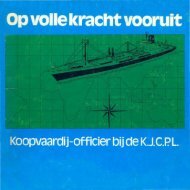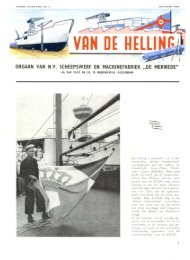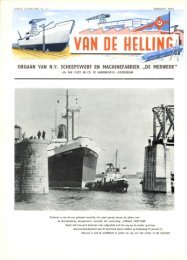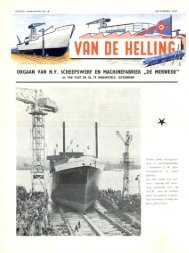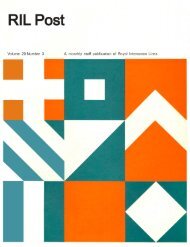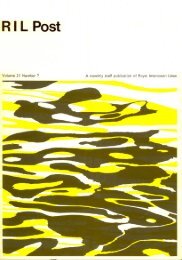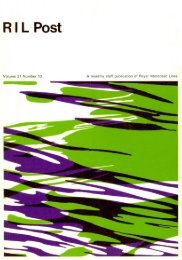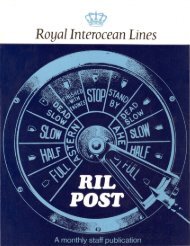You also want an ePaper? Increase the reach of your titles
YUMPU automatically turns print PDFs into web optimized ePapers that Google loves.
NSU's new containership, ABEL<br />
TASMAN, like others of her vast<br />
size, will present certain manoeuvring<br />
problems to her Master<br />
and officers. They are not unprepared,<br />
however, for they have<br />
been getting ready for the job<br />
without ever having been at sea<br />
with the ship, thanks to the 'ship's<br />
simulator'.<br />
This comprehensive simulator, the<br />
latest development of earlier experimental<br />
models. came into being<br />
in March, 1970 and is the only<br />
one of its kind in the world. It<br />
was constructed by the Dutch<br />
Organization for Applied Physical<br />
Research, together with the<br />
Technical University at De lft. In<br />
combination with an analogue<br />
computer, slide projector and a<br />
registration apparatus, the new<br />
simulator gives officers ashore an<br />
opportunity to study the movements<br />
of a ship in all weather. sea<br />
and coastal conditions.<br />
In 1969, the Board of Directors<br />
of VNS, who had been following<br />
developments with interest, decided<br />
to have ABEL TASMAN<br />
put on the simulator. So it was<br />
possible for some Nedlloyd M asters<br />
and Chief Officers to make<br />
'trial runs'.<br />
It was a five-day course during<br />
which they were 'berthed' on the<br />
fourth floor of a large building in<br />
Delft. Inside was a complete replica<br />
of a wheelhouse. equipped<br />
with every modern navigational<br />
aid except radar. Decca charts<br />
were used, and particularly useful<br />
was the instrument indicating the<br />
vessel's turning speed.<br />
T.S. ' SIMULATOR '<br />
A perfectly designed<br />
and familiar bridge.<br />
The view from the wheelhouse,<br />
over the foreship, of the horizon,<br />
sea, coast or harbour entrance<br />
(see photographs) is obtained by<br />
projecting a number of slides on<br />
to a curved screen. T he relative<br />
movements of the coastline as the<br />
ship 'approaches' are very realistic<br />
and true to life.<br />
A computer has been fed with all<br />
the re levant details of t he ABEL<br />
TASMAN, measurements, characteristics<br />
of steering and propulsion,<br />
and synchronizes these with<br />
rudder and engine manoeuvres to<br />
cause the appropriate picture to<br />
be projected on to the screen and<br />
to give the bridge instruments<br />
exact information. The unobstructed<br />
view covers an arc of 120°,<br />
60° to each side.<br />
In order to be able to study the<br />
novices' efforts afterwards. the<br />
results of the manoeuvres are<br />
automatically recorded.<br />
The simulator has a wide range<br />
of possibilities, both in regard to<br />
a ship and her characteristics and<br />
also in connection with outside<br />
influences.<br />
Speed can be altered by increasing<br />
or decreasing engine revolutions,<br />
stopping and/ or reversing. The<br />
corresponding c hanges. as well as<br />
the drift caused by the propellor,<br />
are brought into the calculations.<br />
Course alterations in open sea are<br />
unrestricted, but near a coastline,<br />
m aximum alterations are 90° to<br />
starboard and 60° to port.<br />
Normal visibility and fog can be<br />
simulated. Winds can be given<br />
46<br />
any direction or force, with variations<br />
if required, and the same<br />
can be said of currents with their<br />
resulting effects on the vessel.<br />
Shallow water can be simulated,<br />
but for ABEL TASMAN, only deep<br />
water was used.<br />
When simulating the open sea,<br />
there is no restriction on the<br />
distance to be covered. The maximum<br />
distance from a coast is<br />
about 10 miles, the coastline itself<br />
being about 8 miles long. When<br />
approaching a port, a distance of<br />
about 3 miles is simulated from<br />
ship to breakwater-heads.<br />
The coastline has three leading<br />
lines and landmarks for bearings.<br />
The port area has one leading<br />
line, breakwaters, towers, cranes<br />
etc. VHF is installed to allow<br />
ship/ shore traffic and shore radar<br />
control.<br />
The five-day programme for the<br />
Nedlloyd officers was as follows:<br />
1st Day: explanation of the<br />
simulator. Sailing in leading<br />
lines.<br />
2nd Day: sailing in leading lines,<br />
combined with anchoring.<br />
3rd Day: bringing the ship into<br />
port.<br />
4th Day: repetition of 2nd and<br />
3rd days.<br />
5th Day: man-overboard manoeuvres,<br />
Williamson turn,<br />
turning circles and stopping<br />
distance. Repetition of 'port<br />
manoeuvres'.



